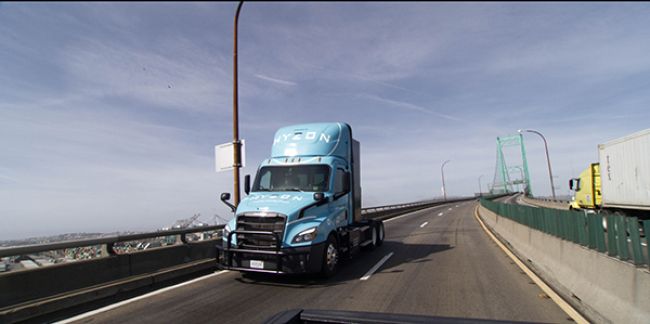
The Latest Developments in the Hydrogen Fuel-Cell Truck Market
Here’s what you need to know about the evolution of this alternative fuel.
Fuel cells powered by hydrogen have become an attractive technology because hydrogen powers an electric motor – without plugging in, as you do with a battery-electric vehicle – and the only emission out of the tailpipe is water.
Big-name truck makers including Toyota, Kenworth and Navistar have entered the fray. And then there are new entrants like Nikola Motor Co. and Hyzon Motors.
Early development has focused on Class 8 trucks for the over-the-road freight market. Light-duty passenger vehicles from Toyota and Honda have been in long-term trials, primarily in Southern California. The state has worked with automakers and suppliers to build the fueling infrastructure. Development in the vocational/medium-duty segment lags behind Class 8 trucks that are under pressure to reduce emissions.
Hydrogen is already well-established in some markets, such as forklifts for warehouses and public transportation. In addition to building fuel-cell-first vehicles, Hyzon Motors launched a repower program to convert existing diesel trucks to hydrogen fuel-cell operation. Navistar International has partnered with GM on fuel-cell semi-trucks that will be piloted by over-the-road carrier J.B. Hunt Transport. According to Navistar, the fuel cell is designed to fit into Class 5, 6, 7 or 8 trucks.
A hydrogen fuel-cell vehicle is similar to a battery-powered electric vehicle. The primary difference is the source of the electricity.
A battery stores electricity generated elsewhere. A hydrogen fuel cell produces electricity through an electrochemical reaction between a fuel (hydrogen) and oxygen in the environment. In the fuel cell, hydrogen and oxygen combine to generate electrical energy, and the exhaust is harmless water vapor.
A hydrogen vehicle has the same characteristics as a battery-powered vehicle, such as quick acceleration, near-silent driving without vibrations and, most importantly, zero tailpipe emissions. Typically, a hydrogen vehicle has a range on par with a diesel vehicle.
A Big Advantage
One of the big advantages is the time it takes to refuel. Battery EVs take up to several hours to recharge, depending on the charger level and battery state.
“Filling a hydrogen truck, on the other hand, takes approximately the same amount of time as filling a diesel truck,” said Pat Griffin, president of vehicle operations at Hyzon Motors (www.hyzonmotors.com), which manufactures hydrogen fuel-cell vehicles.
Although hydrogen is the most abundant element in the universe, it’s not readily found in fuel form. It takes other forms of energy to produce hydrogen from water or fossil-fuel feedstocks.
Southern California is a hub for hydrogen dispensation stations; there are few in other states. The federal 2021 Infrastructure Investment and Jobs Act included $7 billion to fund the creation of six hubs across the country to reduce the cost of hydrogen fuel.
Hydrogen fuel costs about $16 per kilogram, roughly equivalent to a gallon of diesel that costs $5 to $6. The economics of hydrogen vary compared to the cost of fuels and energy to produce it. However, the environmental benefits may be worth the higher fuel cost, which should fall as the production and distribution infrastructure develops.
Hydrogen can be produced in a variety of ways, some more environmentally friendly than others. Each type is designated by a color. The most desirable fuel is so-called green hydrogen, made using electricity from renewable resources. Others are made using fossil fuels, so they are less sustainable overall but still reduce tailpipe emissions.
A hydrogen production facility could support operations in areas where the electric grid cannot be upgraded, both to recharge a fleet of battery EVs and to take advantage of tax incentives.
Fleet operators could install their own hydrogen production and dispensing facilities. The cost of a hydrogen dispensing station is similar to that of a diesel refueling station.
“Localized hydrogen production, especially when close to dispensing and in alignment with vehicle deployments, greatly reduces the overall fuel cost by lessening the financial burden of transporting hydrogen across significant distances,” Griffin said.
Fuel cells aren’t the only application for hydrogen. Cummins is developing internal combustion engines that burn hydrogen rather than diesel fuel. The design is supposed to be fuel agnostic, so the only difference is in the components above the head gasket to match the fuel type. Cummins expects 15- and 6.7-liter models to go into full production in 2027.
Before investing in hydrogen vehicles and infrastructure, fleet managers should evaluate duty cycles and the distance and duration of routes.
“Hydrogen fuel-cell electric vehicles have a refueling time comparable to diesel trucks and can run back-to-back shifts without requiring idle charging time – well-suited for trucks that run two or three shifts per day,” Griffin said.
About the Author: Gary L. Wollenhaupt is a Phoenix-based freelance writer who covers the transportation, energy and technology sectors for a variety of publications and companies.
Image courtesy of Hyzon
- What’s New in Truck and Van Upfits for 2023?
- Pitfalls to Avoid When Transitioning to a Fleet Management Information System
- Despite the Momentum for Electric Vehicles, the Future is Still Uncertain
- ATVs and UTVs: Minimizing the Hazards
- Work Truck Week 2023 Heads Back to Indy
- Spec’ing Truck-Mounted Air Compressors
- The Latest Developments in the Hydrogen Fuel-Cell Truck Market
- ‘The Checklist Manifesto’ for High-Performing Fleet Professionals
- 6 Lessons Learned (So Far) on the Fast Track to an All-Electric Fleet
- The State of Fleet Maintenance in 2023

